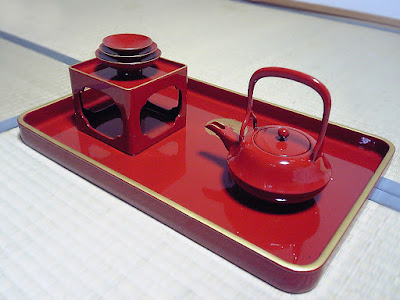Cha Kaiseki, the meal during the tea ceremony. ちゃかいせき、茶懐石
We often only know the part of the tea ceremony where a bowl of strong green tea is prepared by the host and offered to the guests in the small and soberly decorated tea room. But a full tea ceremony also includes a light meal because strong matcha tea can be a bit heavy on the stomach. This is called “a stone in the bosom” (kaiseki), after the legendary custom of Buddhist monks to hold a warm stone to their chest to combat the feelings of hunger.

[Wanmori]
The menu is seasonal and based on the structure of ichiju sansai. It starts with a tray with three dishes: rice on the left, miso soup on the right, and farthest from the guest mukozuke, “the dish on the other side of the tray” - usually sashimi. Sake is also served at this time. While this tray with bowls is left to eat more rice, a cooked dish follows in a lacquerware bowl with a lid (wanmori) – the ingredients, which are usually seafood, are in a soup or stock. Wanmori is difficult to prepare and has been referred to as the focal point of cha-kaiseki. This is followed by yakimono, a grilled dish, usually fish again, now served on an earthenware dish or plate.
On special occasions, which warrant a more elaborate meal, another course called azukebachi is then served. This means “entrusted bowls” and indeed it involves two dishes, a niawase or several ingredients simmered together, and a cooked salad. More sake is also served here, while guests can also ask for extra rice. Then a clear soup (suimono, also called hashi-arai, literally “to wash the chopsticks”) with hassun, two small delicacies, one from the sea and one from the mountains. The name of this dish comes from the earthenware dish that is used, which measures eight sun (hassun) or 24.1 cm. If the guests allow themselves to be persuaded to more sake after this dish, a small snack is served with it, called shiizakana ("a forced bite"). The meal concludes with konomono (pickled vegetables) and yuto, literally washing the rice bowl with hot water so as not to lose even the last, scattered grains. That hot water, already flavored by boiling it in the rice pan, is presented in a beautiful lacquer pot with a spout and lid.
Cha-kaiseki is light and relatively simple in principle. Initially, it was cooked by one person, the host at the tea ceremony who also had his other duties. However, he did not eat. Cha-kaiseki is served in the tea room and is surrounded by the necessary ritual courtesies and formalities. Japanese haute cuisine, kaiseki, which is more elaborate and festive, finds its origin in this cha kaiseki meal.
Photo own work.
Japanese Food Dictionary

